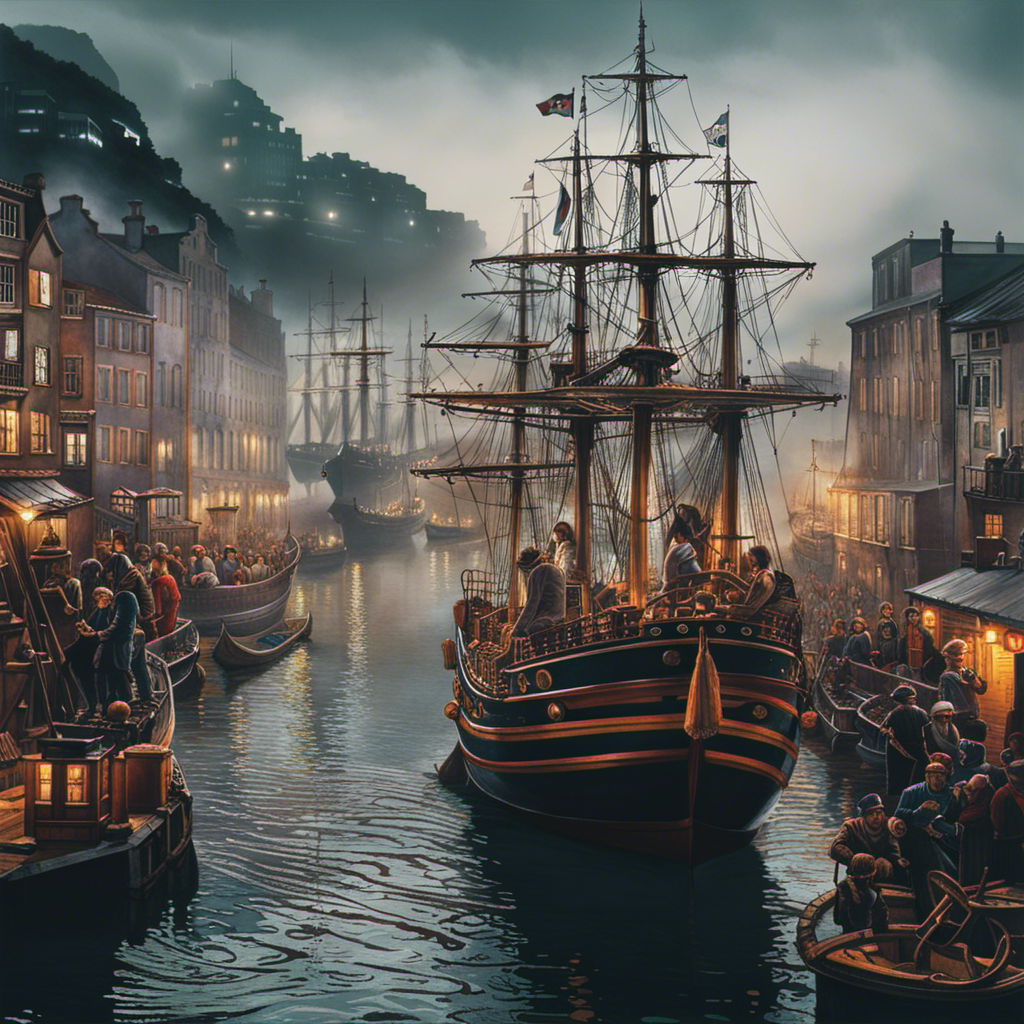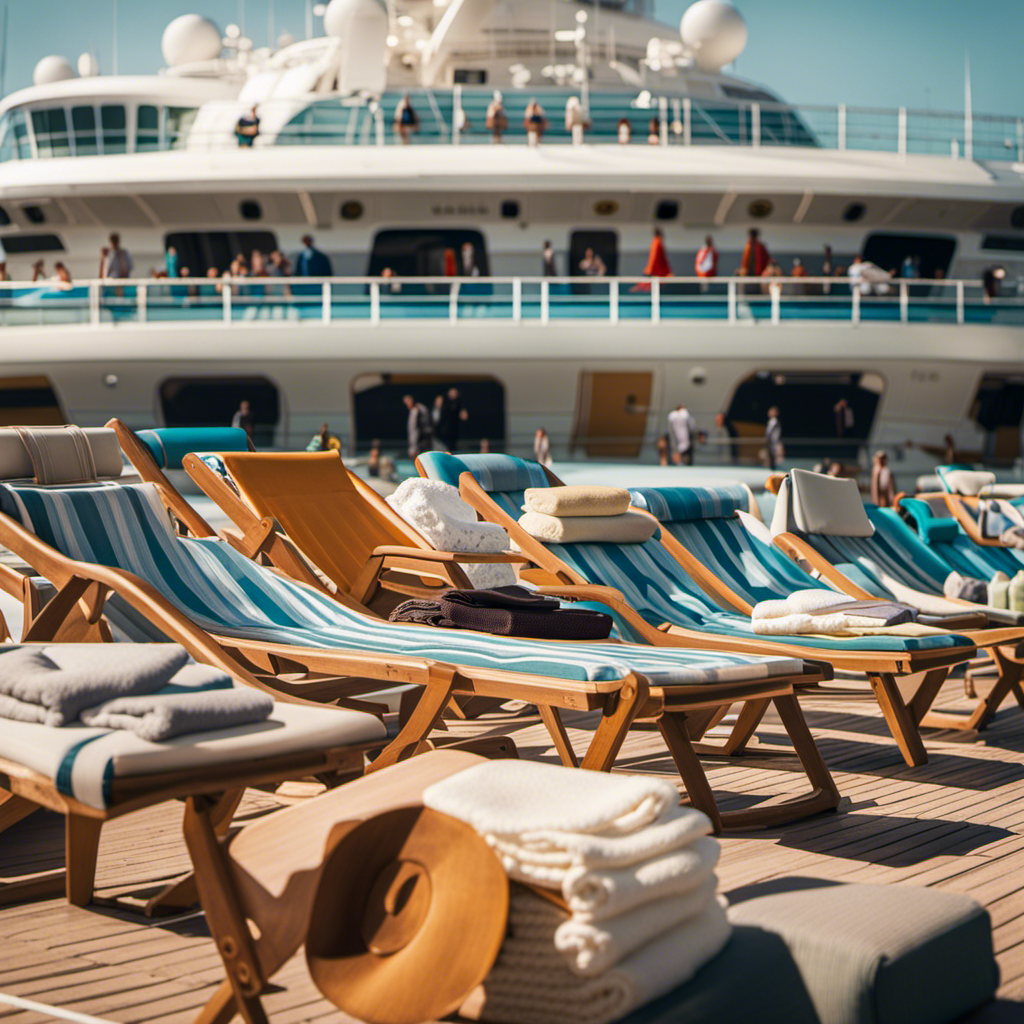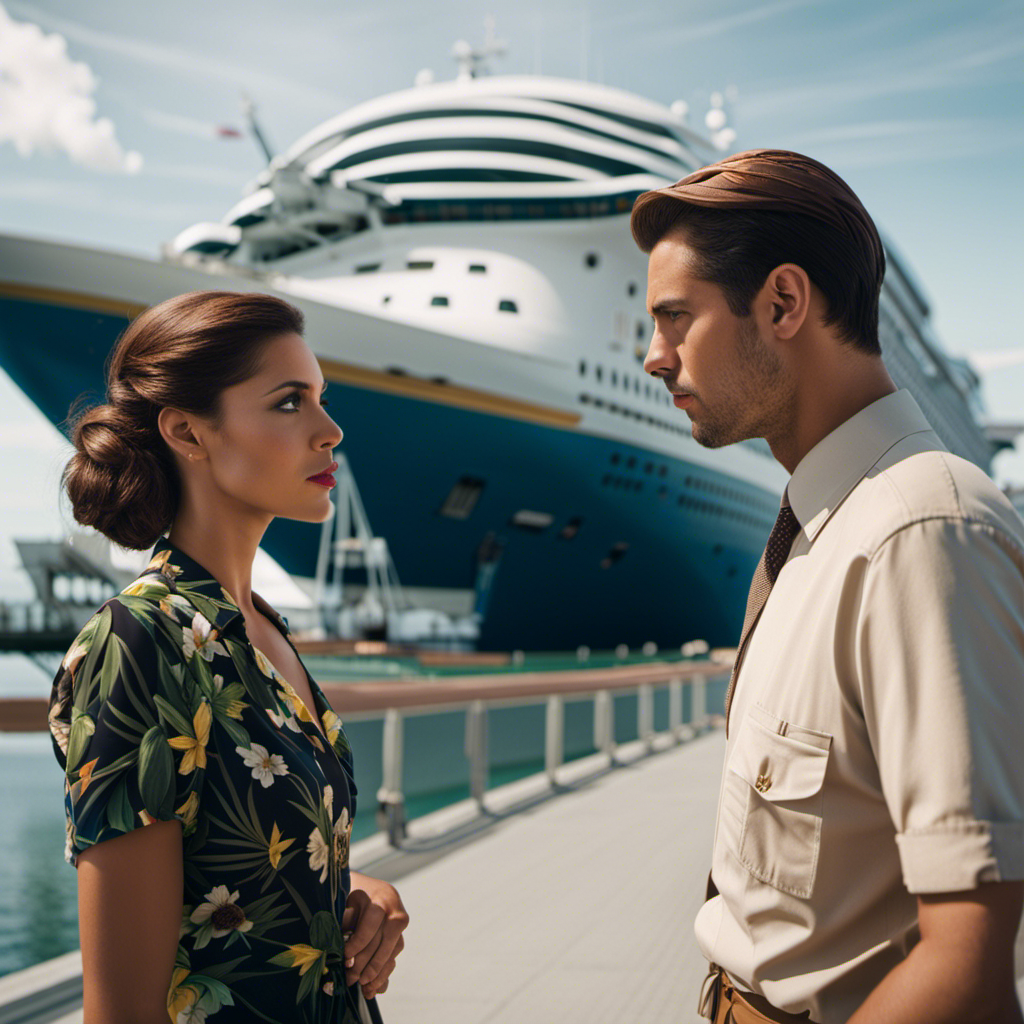Inside the vibrant surroundings of Horta’s Maritime Painting Collection, the air is filled with an ironic quality.
Here, in this world-renowned collection, sailors have left behind paintings as a superstitious act for safe voyages. With each stroke of the brush, they craft depictions of boats, sea creatures, and symbols of good luck.
These paintings, layered one on top of the other, create a cycle of protection. It is fascinating to witness how these works of art, born out of superstition, bring peace of mind and optimism to sailors as they embark on their journeys.
Key Takeaways
- Horta’s Maritime Painting Collection is the largest in the world and holds great historical and cultural significance.
- The paintings in the collection depict boats, sea creatures, and symbols of good luck, serving as a superstition for safe voyages.
- Superstition plays a crucial role in sailors’ safety, with non-compliance linked to nautical disasters.
- Horta’s Marina, where the collection is located, is a hub of nautical traditions and attracts tourists due to its cultural significance.
Historical Significance of Horta’s Maritime Painting Collection
I’m fascinated by the historical significance of Horta’s Maritime Painting Collection and how it showcases the superstitions and traditions of sailors throughout the years.
This collection, located in Marina da Horta on the Azores Island of Faial, is the largest maritime painting collection in the world. The paintings, left by sailors as a superstition for safe voyages, depict boats, sea creatures, and symbols of good luck. What’s interesting is that new paintings are painted over old ones, creating a layered history of seafaring beliefs.
Horta’s Marina, the main harbor of the Azores, has cultural significance tied to corsairs, smugglers, and pirates. The superstition and sea lore surrounding the paintings are rooted in the sailors’ desire to ward off shipwrecks and disasters at sea.
This collection not only represents the historical background of seafaring but also holds immense cultural significance in the maritime world.
The Magnitude of Horta’s Maritime Painting Collection
Located in Marina da Horta on the Azores Island of Faial, the sheer number of paintings in this collection is astounding.
The historical preservation and cultural heritage represented in Horta’s Maritime Painting Collection are truly remarkable.
As I walk through the marina, I am surrounded by a sea of vibrant artwork left by sailors as a superstition for safe voyages.
The paintings depict boats, sea creatures, and symbols of good luck, creating a vivid tapestry of maritime lore.
Each stroke of the brush tells a story of gratitude for the safe harbor of Horta and the optimism for future voyages.
This collection serves as a testament to the power of superstition and the deep connection between sailors and the sea.
It is a treasure that must be preserved for future generations to appreciate and understand the rich cultural heritage tied to this maritime tradition.
Symbolism and Meaning in Horta’s Maritime Paintings
As I walk along the breakwater and piers of Horta’s marina, I am captivated by the symbolism and meaning behind the vibrant maritime paintings left by sailors. These paintings, which form the largest maritime painting collection in the world, are not just mere decorations, but carry deep cultural significance. They serve as a superstition for safe voyages, with sailors believing that painting these images on the walls and piers will protect them from shipwrecks and other nautical disasters. The paintings depict boats, sea creatures, and symbols of good luck, replicating compasses and other navigational tools. Each painting tells a story, a testament to the gratitude of sailors for the safe harbor of Horta, and brings optimism for their future voyages. These paintings are not just art, but a powerful representation of the sailors’ hopes and fears, making Horta’s maritime painting collection a cultural treasure.
| Symbolism | Meaning |
|---|---|
| Boats | Safe and successful voyages |
| Sea creatures | Protection from the unpredictable |
| Symbols of good luck | Favorable conditions |
| Replication of navigational tools | Accurate and reliable navigation |
The Connection Between Superstition and Sailors’ Safety
Walking along the breakwater and piers of Horta’s marina, I can’t help but be fascinated by the strong bond between sailors’ superstitions and their safety at sea. The psychological impact of superstition on sailors is undeniable.
Horta’s maritime painting collection holds cultural significance as it serves as a physical manifestation of these beliefs. Sailors leave paintings as a form of protection, depicting boats, sea creatures, and symbols of good luck. The act of painting is also a way for sailors to transform into artists, warding off shipwrecks and disasters.
Non-compliance with these superstitions has been linked to nautical disasters, like the mysterious disappearance of the Ariadne. These paintings on the breakwater and piers not only offer protection but also provide sailors with peace of mind, easing their fears and ensuring safe voyages.
The power of superstition cannot be underestimated in the lives of sailors navigating the unpredictable seas.
Exploring Horta’s Marina: A Hub of Nautical Traditions
Exploring Horta’s Marina, I am amazed by the rich heritage of nautical traditions that thrive in this bustling hub of seafaring culture.
The role of Horta’s maritime painting collection in local tourism
Horta’s Marina, located on the Azores Island of Faial, is home to the largest maritime painting collection in the world. These paintings, left by sailors as a superstition for safe voyages, depict boats, sea creatures, and symbols of good luck. The paintings on the breakwater and piers serve as protection, as sailors believe that non-compliance with this superstition is linked to nautical disasters. The completion of paintings brings optimism for safe voyages, and artists replicate compasses and other navigational tools in their artwork.
The cultural significance of Horta’s marina in the Azores
The marina itself is the main harbor of the Azores and the fourth most visited marina in the world, welcoming nearly 1,500 boats each year with berths for 300 yachts. Its cultural heritage is tied to corsairs, smugglers, and pirates, adding to its allure for visitors. The power of superstition in Horta’s marina is evident in the tranquil and warm subtropical climate, easing sailors’ fears and boat troubles. The paintings left by sailors are vivid testaments to this superstition, serving as reminders of the gratitude for the safe harbor of Horta.
As I explore this vibrant marina, I can’t help but appreciate the cultural significance it holds in the Azores and the role it plays in attracting tourists from all over the world.
The Role of Superstition in Nautical Disasters
As we continue our exploration of Horta’s maritime traditions, it is important to delve into the role of superstition in sailors’ beliefs and the impact it has on maritime culture.
Superstitions have long been intertwined with seafaring, as sailors have sought ways to protect themselves from the unpredictable and treacherous nature of the sea. The maritime painting collection in Horta serves as a testament to these beliefs. Sailors, transformed into artists, paint images of boats, sea creatures, and symbols of good luck as a form of protection against shipwrecks.
These paintings, often found on breakwaters and piers, are believed to ward off nautical disasters. Non-compliance with these superstitions has even been linked to tragic incidents, such as the mysterious disappearance of the Ariadne.
The impact of superstition on maritime culture is profound, as it brings a sense of comfort and optimism to sailors, while also leaving a lasting mark on the walls and piers of Horta.
Artistic Expressions of Gratitude and Protection in Horta
While observing the vibrant artistic expressions in Horta, I am amazed by the sailors’ gratitude and protection depicted in the paintings. These artworks not only showcase the skillful use of artistic techniques, but also highlight the cultural influences that have shaped the maritime painting collection in Horta.
The sailors’ gratitude is evident in the intricate details and vivid colors used to represent their boats, as well as the symbols of good luck scattered throughout the paintings. The paintings also serve as a form of protection, with sailors believing that by leaving their artwork behind, they can ward off shipwrecks and ensure safe voyages.
This unique blend of artistic expression and superstition is a testament to the deep connection between seafaring traditions and the art world.
Navigational Tools and Superstition: A Unique Combination
I’m fascinated by the unique combination of navigational tools and superstition that is showcased in the vibrant artworks of Horta.
The exploration of navigational tools in maritime paintings reveals the ingenuity of sailors in navigating treacherous waters. From compasses to astrolabes, these paintings replicate the tools that guided them on their voyages.
However, what truly sets these artworks apart is the influence of superstition on navigational practices. Sailors believed that these paintings would bring them good luck and protect them from shipwrecks. This superstition was born out of the harrowing tales of nautical disasters, like the infamous disappearance of the Ariadne.
The paintings on the breakwater and piers of Horta serve as a form of protection, instilling hope and optimism for safe voyages.
It is fascinating to see how these navigational tools and superstitions intertwine, creating a rich tapestry of art and belief.
Superstition as a Source of Comfort and Optimism for Sailors
Sailors find comfort and optimism in the belief that the paintings on the walls and piers of Horta protect them from shipwrecks. This superstition has a profound psychological impact on sailors, providing them with a sense of security and peace of mind as they embark on their voyages.
The role of the community in perpetuating maritime superstitions is crucial in Horta. The paintings left by sailors serve as a visual representation of their shared belief and collective faith in the power of superstition. This communal practice reinforces the sailors’ sense of belonging and unity, allowing them to face the unpredictable nature of the sea with a renewed sense of hope.
In this way, the maritime painting collection in Horta not only safeguards the sailors’ physical well-being but also nurtures their mental and emotional resilience.
Leaving a Lasting Legacy: Horta’s Maritime Paintings
As we delve further into the fascinating world of maritime superstitions, it becomes evident that Horta’s maritime painting collection holds a significant place in history.
The cultural significance of these paintings cannot be overstated, as they serve as a lasting legacy of the sailors who once traversed the treacherous seas.
Here are some key points about the history of maritime superstitions and the cultural significance of Horta’s paintings:
-
Horta’s maritime painting collection is located in Marina da Horta on the Azores Island of Faial, boasting the title of the largest maritime painting collection in the world.
-
These paintings were left by sailors as a superstition for safe voyages, depicting boats, sea creatures, and symbols of good luck.
-
The tradition involves painting new artworks over the old ones, symbolizing the ongoing belief in the power of superstition.
-
Horta’s Marina, the main harbor of the Azores, has a rich cultural heritage tied to corsairs, smugglers, and pirates, making the paintings a testament to the nautical history of the region.
-
The paintings on breakwaters and piers not only serve as protection but also reflect the sailors’ transformative journey into becoming artists, warding off shipwrecks and ensuring safe passage.
The history of maritime superstitions and the cultural significance of Horta’s paintings highlight the deep-rooted beliefs and practices of sailors, and their enduring impact on the maritime world.
Frequently Asked Questions
How Many Paintings Are Currently in Horta’s Maritime Painting Collection?
There are currently over 1,000 paintings in Horta’s maritime painting collection. The significance of maritime superstitions and the historical importance of these paintings are evident in the rich history and culture of Horta.
What Is the Process for Painting Over Old Paintings With New Ones in the Collection?
Exploring the artistic techniques used in the process of painting over old artworks in Horta’s maritime collection, sailors carefully layer new paintings on top, unveiling hidden stories and preserving the superstition’s power.
Are There Any Specific Sea Creatures That Are Commonly Depicted in the Paintings?
Sea creatures commonly depicted in Horta’s maritime paintings include dolphins, whales, and mermaids. These creatures hold symbolic meanings of protection and good luck. Superstition heavily influences their depiction, as sailors believe they bring safety and smooth voyages.
How Do the Paintings on the Breakwater and Piers Serve as Protection for Sailors?
The maritime paintings on Horta’s breakwater and piers serve as protection for sailors by embodying symbolism and meaning. They reflect the cultural significance of superstition in sailors’ lives and provide a sense of comfort and security amidst the unpredictable nature of the sea.
Are There Any Specific Navigational Tools That Are Frequently Replicated in the Paintings?
Yes, navigational tools such as compasses are frequently replicated in the maritime paintings. This reflects the superstition of sailors seeking protection and safe voyages, as these tools are essential for navigation at sea.










